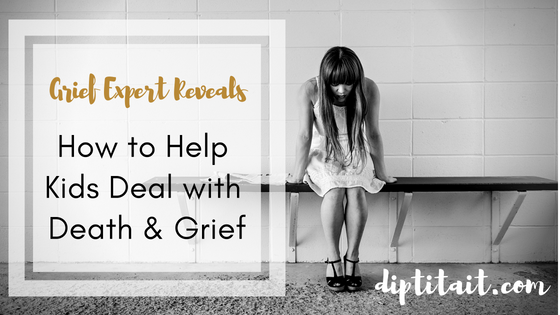Talking openly to kids about Death and Grief helps them Cope Better
Death and grief are hot topics in the news. I saw an increase of child anxiety in my hypnotherapy practice particularly after the shocking and tragic explosion after the Ariana Grande concert in Manchester, killing 22 people in June, a few years ago.
The tragic incident triggered many questions and stirred up a lot of discomfort, not just within our media, but also within the minds of our children and teenagers.
Even though death is part of life, we don’t really think about it that much until it happens to someone we know and then we are faced with it.
Unbelievable incidents like this rubs the subject of death in all our faces and suddenly we find ourselves in a situation that we are not sure how to mentally cope with.
Because this incident involved children and teenagers, this could explain why kids hearing about this may be particularly shaken by the news.
They may be suddenly asking questions about death and feeling anxious or fearful about their own safety and perhaps even questioning their own mortality.
With this in mind, this subject deserves a honest, frank but sensitive discussion with our kids, similar to conversations we have had or need to have about the birds and the bees.
It may not be the topic that we find the easiest to discuss, but it’s better talked about openly with our kids rather than them left wondering.
When things remain undiscussed, we run the risk of the child making stuff up in their mind or taking on negative beliefs and feelings which could have an adverse effect on their emotional wellbeing in the long run.
7 Emotions linked to Grief
Our children could well be experiencing emotions that may not be familiar with. What these children are actually going through is grief.
Grief isn’t a simple and linear process, it is a mish-mash of these emotions that can swirl around the mind and body, I call it a grief cocktail.
The ingredients that make up the cocktail of grief are:
- Anxiety
- Disbelief
- Shock
- Fear
- Anger
- Guilt
- Sadness
Grief is an overwhelming feeling because of the overload of emotions that the brain and body has to process and unexpectedly cope with in a short amount of time.
Grief is hard enough for an adult to deal with, and even harder for children who have less intellectual and logical capacity to be able to weigh things up in a rational way, so will find these emotions harder to cope with.
This is why children and teenagers can sometimes throw tantrums – the tantrum is like the fuse in our fusebox blowing.
Think of the brain like a intricately wired up circuit board, grief would be similar to a surge of electricity in the circuit board, and to protect the brain from blowing up, the fuse blows instead.
The fuse here being the child suddenly expressing fear of staying away from home, or anxiety while walking to school, or even resistance to going out shopping.
Fight, Flight and Freeze Mode
Normal and everyday activities could suddenly be perceived by the child as threatening and dangerous. This is because grief activates the vigilant part of our mind.
The child when feeling overly emotional goes into a fight flight or freeze mode, which generally means they are internally stressed and their stressed brain can trigger the negative imagination which results in worst case scenario thinking.
This negative mindset causes them to suddenly become over protective over their safety, territorial over their environment or people they are close to, withdrawn and uncommunicative and even in some cases obsessional with their thinking and behaviours.
3 tips for helping you and your child understand death and manage grief
-
Use stories to explain the natural cycle of life and death
The brain is an imaginative place and really loves stories. If we think about the bedtime story, it is a comforting time, and creates a safe place in the mind.
It’s important to use the storytelling to help the children link their experience to something else that feels familiar, and this creates a comfortable reference point in their mind.
A concept like death may not feel familiar, but when we link it to something else that is similar, something they can compare it to that feels okay, suddenly the new experience will feel a bit easier to process.
A good metaphor is like dipping a biscuit into hot tea, it softens it, making it easier to swallow. The story or metaphor provides a bridge towards understanding and acceptance.
For example, using the explanation of the cycle of nature: A Summertime leaf living happily on a tree for that season and then falling off in the Autumn and decomposing and disappearing in Winter but in its place a Springtime bud regrows and turns into another Summertime leaf a year later can be a nice way of talking about how death is part of our natural world.
There is a wonderful book that I use in my hypnotherapy practice called Effective Metaphors for Children by Tayma Wallbridge and Allegra Etheridge that I would highly recommend to explain a variety of life’s twists and turns to children.
It’s important we teach our children that death is inevitable and of course it is upsetting and can cause emotional overwhelm, especially when it is not a natural occurrence.
Nevertheless, these shocking events in the news highlight this subject and this exposure can be used to educate and teach children the facts of life and death in a logical way.
Education and open discussions about this subject can smooth over the anxiety or fear because it is in the open and questions can be answered in a sensible way.
-
Label new emotions to give them a safe place in the mind
When a new emotion is felt, the unfamiliarity can cause confusion in the subconscious mind as the brain will not have a reference to this emotion and the process of what to do with it won’t have been developed.
If it is negative feeling that discomfort of not knowing what to do with it can spill over into over-worry. To help alleviate the worry, it is a good idea to explore the new emotions with the child to create some familiarity with it and this can help with processing it appropriately.
For example if the child understands sadness, but has never felt guilt. If they describe guilt and link it to sadness, their brain can file it away as a relevant emotion to feel in the circumstance.
Ask your child to write down the new emotions that they are feeling and describe them in as many words as they can. As you write these words down, they become labeled by the brain as a new category – like in a filing system.
So, when the child experiences that emotion again it has an appropriate place to be filed into.
If the emotion is discussed in a way that you can place a value on it, the brain understands the usefulness of the emotion and it accepts it rather than rejects it as a threat to the system.
This gives the emotion a container to be held in rather than leaking out into a tantrum or an emotional outburst.
-
Ask this question: ‘IS THIS THOUGHT TRUE?’
When there has been a shocking event like this presented to us, our basic ‘survival’ or emotional brain will naturally want to keep us safe and protect us from harm. It will link to that event and worry about whether this event will happen again and want to put up barriers and protection so we are always safe and out of danger.
This is when our brain goes into the fight, flight or freeze mode. It is the way of the emotional brain taking control and getting out of a ‘dangerous’ situation quickly and efficiently.
Usually when the brain goes into the Fight, Flight, Freeze, it is in the ‘stress’ mode. When the brain senses stress in the system, it will stop thinking positively, because positive thinking does not get you anywhere if you are in danger, but on the flip side, it will go into worse case scenario mode.
The brain will come up with a negative forecast of the future when it senses danger or a threat so you will get out of the situation rather than stay in danger.
Of course, this is the brain’s way of keeping us safe. If there really were a threat, we would be pleased of the vigilant and stressed mind taking over, because it would help us exit the situation rapidly.
When the brain is in the ‘stress’ mode, it has lost the ability to think rationally and sensibly, so it will use the negative imagination to spiral downwards into the worst case scenario.
Now, this mode is great when we really are in a dangerous situation, but because the emotional brain is not rational, it will not be able to make a judgment call based on reality or facts.
So, usually what happens is we begin to over react in a ‘normal’ situation, as the brain has perceived normal as threatening as well.
For example the thought, “School is dangerous, because it will blow up.”
If the child has this thought or a thought similar to this and expresses it to you, If you ask the question “Is this thought true?”. The logical brain gets involved and helps to make a proper assessment and identify the over reaction. This can take the edge off the threat and help categorise it as a perceived threat and not a real one.
Our children have a developing rational mind, they are very much emotional creatures. We know this because they are not able to discuss the pro’s and con’s easily, this is an adult skill.
However, the adult can help the child think about things in a different way by asking the right questions and helping the child understand that the worrying thoughts may feel real at the time, but they are actually not real at that time.
Explore the answers to the question IS THIS THOUGHT TRUE? and this will help the child begin to apply some logic to the thought, which will help calm the emotional mind down.
About Dipti Tait – Author of Good Grief

Dipti Tait is the author of Good Grief , a Solution Focused Hypnotherapist and Lecturer.
Dipti wrote this self help book about how to deal with grief when she lost both her parents to cancer. This was her way of coping, and shares her story and helpful advice with you in this easy to digest book that you can carry around with you.
Visit the website for more information about grief and to buy a limited signed copy of Good Grief.
Originally published at diptitait.com


